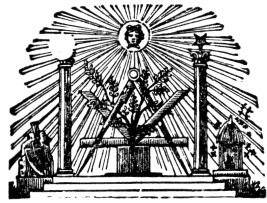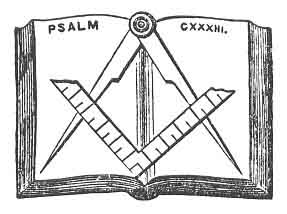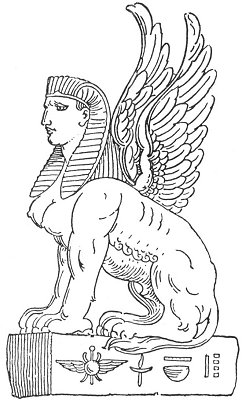After the candidate is brought to light, the Master addresses him as follows: “Brother, on being brought to light, you first discover three great lights in Masonry, by the assistance of three lesser; they are, thus explained: the three great lights in Masonry are the Holy Bible, Square and Compass. The Holy Bible is given to us as a rule and guide for our faith and practice; the Square, to square our
p. 23
actions, and the Compass to keep us in due bounds with all mankind, but more especially with the brethren. The three lesser lights are three burning tapers, or candles placed on candlesticks (some say, or candles on pedestals) they represent the sun, moon, and Master of the lodge, and are thus explained. As the sun rules the day and the moon governs the night, so ought the worshipful Master with equal regularity to rule and govern his lodge, or cause the same to be done; you next discover me, as Master of this lodge, approaching you from the east upon the first step of Masonry, under the sign and due-guard of an Entered Apprentice Mason. (The sign and due-guard has been explained.) This is the manner of giving them; imitate me as near as you can, keeping your position. First step off with your left foot, and bring the heel of the right into the hollow thereof, so as to form a square. [This is the first step in Masonry.] The following is the sign of an Entered Apprentice Mason, and is the sign of distress in this degree; you are not to give it unless in distress. [It is given by holding your two hands transversely across each other, the right hand upwards and one inch from the left.] The following is the due-guard of an Entered Apprentice
 |
Mason. [This is given by drawing your right hand across your throat, the thumb next to your throat, your arm as high as the elbow in a horizontal position.] “Brother, I now present you my right hand in token of brotherly love and esteem, and with it the grip and name of the grip of an Entered Apprentice Mason.” The rights hands are joined together as in shaking hands and each sticks his thumb nail into the third joint or upper end of the forefinger; the name of the grip is Boaz, and is to be given in the following manner and no other; the Master first gives the grip and word, and divides it for the instruction of the candidate; the questions are as follows: The Master and candidate holding each other by the grip, as before described, the Master says, “What is this?”
Ans. “A grip.”
“A grip of what?”
Ans. “The grip of an Entered Apprentice Mason.”
p. 24
“Has it a name?”
Ans. “It has.”
“Will you give it to me?”
Ans. “I did not so receive it, neither can I so impart it.”
“What will you do with it?”
Ans. “Letter it or halve it.”
“Halve it and begin.”
Ans. “You begin.”
“Begin you.”
Ans. “B-O.”
“A-Z.”
Ans. ‘BOAZ.”
Master says, “Right, brother Boaz, I greet you. It is the name of the left hand pillar of the porch of King Solomon’s temple. Arise, brother Boaz, and salute the junior and Senior Wardens, as such, and convince them that you have been regularly initiated as an Entered Apprentice Mason, and have got the sign, grip and word.” The Master returns to his seat while the Wardens are examining the candidate, and gets a lambskin or white apron, presents it to the candidate, and observes, “Brother, I now present you with a lambskin or white apron. It is an emblem of innocence, and the badge of a Mason—it has been worn by kings, princes and potentates of the earth, who have never been ashamed to wear it. It is more honorable than the diadems of kings, or pearls of princesses, when worthily worn; it is more ancient than the Golden Fleece or Roman Eagle, more honorable than the Star and Garter, or any other order that can be conferred upon you at this or any other time, except it be in the body of a just and lawfully constituted lodge; you will carry it to the Senior Warden in the west, who will teach you how to wear it as an Entered Apprentice Mason.” The Senior Warden ties the apron on, and turns up the flap instead of letting it fall down in front of the top of the apron. This is the way Entered Apprentice Masons wear, or ought to wear their aprons until they are advanced. The candidate is now conducted to the Master in the east, who says, “Brother, as you are dressed, it is necessary you should have tools to work with; I will now present you with the working tools of an Entered Apprentice

Moe is the founder of GnosticWarrior.com. He is a father, husband, author, martial arts black belt, and an expert in Gnosticism, the occult, and esotericism.






